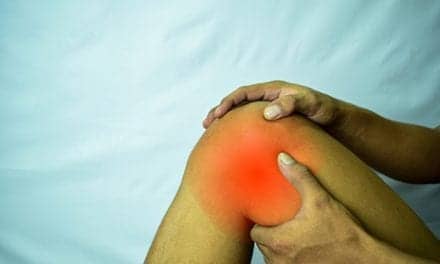Physical therapy, knee joint injections, and topical creams may be underused among osteoarthritis (OA) patients to help treat their pain and other symptoms, according to research that recently appeared in Arthritis Care & Research.
According to results of a secondary analysis of three clinical trials conducted in North Carolina, 39% to 52% of patients with symptomatic hip or knee OA ever had used physical therapy, compared with 70% to 82% who currently use nonprescription and prescription oral pain relievers. Similarly, only 50% to 60% of OA patients used knee injections, and 25% to 39% used topical creams.
“Results suggest potential underutilization of therapies other than oral analgesia. Understanding the gaps between OA treatment guidelines and actual treatment use is critical to improving the quality of OA care,” write Lauren Abbate, MD, PhD, and colleagues from the University of Colorado School of Medicine in Aurora, according to the study, in a media release from Medpage Today.
In this analysis, the researchers studied baseline data of hip or knee OA patients from three randomized clinical trials: the PRIMO-Duke cohort (n=537), from Duke University primary care practices; the PRIMO-VA group (n=300), from the Durham Veterans Affairs Health Care System; and the PATH-IN (n=350) group, from a University of North Carolina-Chapel Hill study assessing physical therapy versus internet-based exercise training for knee OA; the researchers randomized patients to one of three arms: standard physical therapy, an internet-based training program, or control.
The participants’ average age ranged from 61 to 65. The PRIMO-VA cohort was 91.7% male; the other two groups each were more than 70% female. The researchers evaluated self-reported treatments including opioid and non-opioid oral analgesics, topical creams, knee joint injections, and physical therapy for knee OA. They did not assess injections or physical therapy for hip OA.
Patients reported using oral pain relievers most commonly: 82.2%, 77.3%, and 70.0% in PRIMO-Duke, PRIMO-VA, and PATH-IN, respectively, used any type of oral analgesic, most often non-steroidal anti-inflammatory drugs (NSAIDs). Higher WOMAC scores were associated with greater odds of using any oral analgesic in PRIMO-Duke (OR 1.18; 95% CI 1.08-1.28) and PATH-IN (OR 1.14; 95% CI 1.05-1.24, but not in PRIMO-VA (OR 1.04; 95% CI 0.95-1.14).
In PRIMO-VA, however, 29.3% reported using opioids, compared with 13.0% in PRIMO-Duke and 10.3% in PATH-IN.
Overall, patients used other OA treatments less frequently. About 50% to 60% of patients in all three studies ever had a knee injection. Physical therapy use was 38.8%, 47.4%, and 52.0% in PRIMO-Duke, PRIMO-VA, and PATH-IN, respectively, the release explains.
“Opioid treatment is recommended for those unable to tolerate NSAIDs or who have failed other medical therapies, and our study indicates that opioid use was higher among veterans than in the other two cohorts,” the authors write, per the release.
The analysis showed higher physical therapy use than previous research, but evaluated whether patients ever had used physical therapy based on self-reported data, not physician referrals. The researchers noted that they could not determine when patients used physical therapy or any relationship between physical therapy and analgesics. In addition, the team asked about current use of oral medications only and did not explore how long patients used any treatment, including drugs, the release continues.
[Source: Medpage Today]





